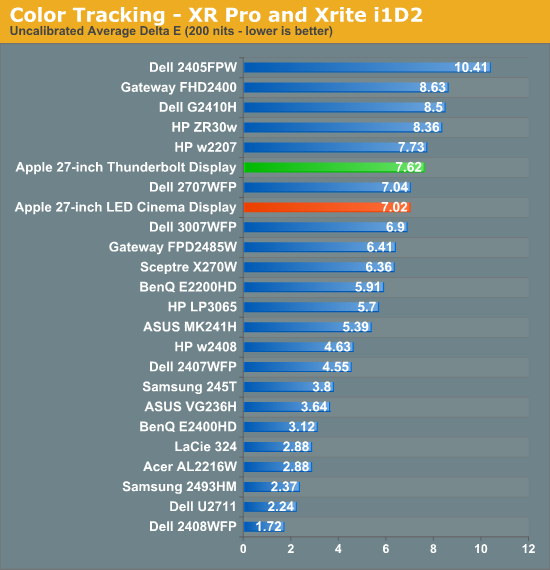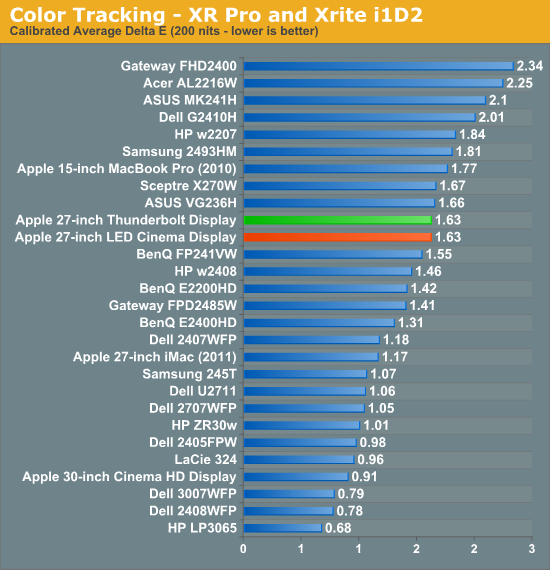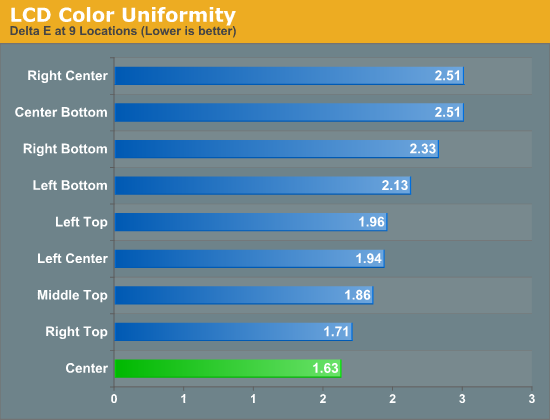The Apple Thunderbolt Display Review
by Anand Lal Shimpi on September 23, 2011 2:56 AM EST- Posted in
- Displays
- Mac
- Apple
- Thunderbolt
- Thunderbolt Display
Display Testing
With all of the extra connectivity there is to test with the Thunderbolt Display we can't forget the actual panel testing. Thankfully this part is pretty simple, the display characteristics are near identical to the 27-inch LED Cinema Display we reviewed last year.
Color Quality
We report two main quality metrics in our display reviews: color accuracy (Delta-E) and color gamut. Color gamut refers to the range of colors the display is able to represent with respect to some color space. In this case, our reference is the AdobeRGB 1998 color space, which is larger than the sRGB color space. So our percentages are reported with respect to this number, and larger is generally better.
Color accuracy (Delta E) refers to the display’s ability to display the correct color requested by the GPU and OS. The difference between the color represented by the display, and the color requested by the GPU is our Delta-E, and lower is better here. In practice, a Delta E under 1.0 is perfect - the chromatic sensitivity of the human eye is not great enough to distinguish a difference. Moving up, a Delta E of 2.0 or less is generally considered fit for use in a professional imaging environment - it isn’t perfect, but it’s hard to gauge the difference. Finally, Delta E of 4.0 and above is considered visible with the human eye. Of course, the big consideration here is frame of reference; unless you have another monitor or some print samples (color checker card) to compare your display with, you probably won’t notice. That is, until you print or view media on another monitor. Then the difference will no doubt be apparent.
As I mentioned in our earlier reviews, we’ve updated our display test bench. We’ve deprecated the Monaco Optix XR Pro colorimeter in favor of an Xrite i1D2 since there are no longer up-to-date drivers for modern platforms.
For these tests, we calibrate the display and try to obtain the best Delta-E we can get at 200 nits of brightness for normal use. We target 6500K and a gamma of 2.2, but sometimes the best performance lies at native temperature and another gamma, so we try to find what the absolute best performance could be. We also take an uncalibrated measurement to show performance out of the box using either the manufacturer supplied color profile, or a generic one with no LUT data. For all of these, dynamic contrast is disabled.

Uncalibrated performance remains fairly similar to last year's LED Cinema Display, however once calibrated the Thunderbolt Display is spot on with its predecessor:

As we mentioned earlier, a sub 2.0 delta E is good enough for professional use. Although not perfect the Thunderbolt Display falls within that range for sure.


We measured slightly lower color gamut on the Thunderbolt Display than the original LED Cinema Display, however the result was much closer to the 2011 27-inch iMac. I couldn't visibly tell any differences and Apple indicates that color gamut shouldn't have changed, so it's quite possible that the differences here are due to our colorimeter and not the panel.
Color Uniformity
Now for color consistency, we take our best calibration profile from the very center at 200 nits and test color accuracy at 9 different places around the LCD display in an evenly distributed grid. We’ve shown before that calibration is localized across the display, partly due to the brightness not being uniform, partly due to the discrete nature of the display itself.

The Thunderbolt Display was fairly uniform across its surface, something we noticed in reviewing the 27-inch LED Cinema Display last year. Uniformity is actually better on this panel than the one we reviewed last year, although in both cases I couldn't really tell any differences.
Peak brightness appears down slightly, but so are the black levels which result in a slightly better contrast ratio. Apple is also calibrating these things at the factory now so white points are now set at around 6300K vs. 7100K on the original 27-inch LED Cinema Display.










275 Comments
View All Comments
GotThumbs - Friday, September 23, 2011 - link
Anand,Love the Video Review format. While I think the product is nice and provides access to new tech, I have issues with Apples proprietary format. During a time where many users are going with multi-monitor configurations (I use dual Dell 30" monitors at work). I think combining functionality in a monitor limits/restricts users down the road. I would have liked to see purhaps an external Thunderbolt expansion system that would mount on the back of ANY monitor (via vesa). This would allow users the flexibility to upgrade/swap monitors as needed/desired. In today's technological world, we should be embracing expansion flexibility instead of restriction. It just seems to me that Apple continues to breed products that are proprietary in nature. Reminds me of the old Packard Bell systems where much of the internal hardware was proprietary. Thanks, but no thanks.
Keep up the good work and best wishes.
PS. I've been an AnandTech reader since your HS days.
Constructor - Friday, September 23, 2011 - link
The TBD just adds to the capabilities of your machine, it doesn't take away from it. You can daisy-chain other Thunderbolt add-ons as you want.Nobody prevents anyone from making a multi-port extension box without a display built in. Apple just chose to do it this way. You can even combine both if you want (and once the other announced extension boxes becomne available).
Beyond Thunderbolt being owned by Intel, there's nothing proprietary about the TBD. It's apparently just a relatively straightforward implementation of some of TB's capabilities.
GotThumbs - Saturday, September 24, 2011 - link
Curious, So what other laptops use a MagSafe connector? Other than Apple of course.Whats also curious as Anand pointed out. Why did Apple CHOOSE to leave out USB 3? Next years version will most likely include this. Just seems more of the same tactics used by Apple to keep its consumers re-purchasing much of the same technology to gain one or two new features.
Same with Itouch, Iphone, and Ipad. Same IOS, two items (Itouch and Iphone) are identical for the most part, but one makes calls. The Itouch and Ipad are same but one has bigger screen. Just seems like Apple is more about 'reselling' similar products to the same consumers. How many people purchased an IPAD2 to replace their IPAD, so they could have the camera feature? Apple could have added the camera into the first version but chose not to. Apple has great marketing, but I'm just not wowed by it like many others.
I'll be interested in seeing Thunderbolt added to more PC component products.
Constructor - Sunday, September 25, 2011 - link
The display works exactly the same without connecting the MagSafe connector, but the charging function is indeed limited to MacBooks (iMacs and Mac minis also can't use it).And USB3 in all the PCs with Intel CPUs you see right now is always done by connecting an external USB3 controller to the CPU. In Macs the PCIe lines used for that are instead used to drive the Thunderbolt controller, which is much more valuable. Especially on mobile CPUs with their limited supply of PCIe lanes it would probably not even be possible to drive both.
The next generation of Intel CPUs will provide USB3 directly anyway – and Apple will be able to provide both TB and USB3 at the same time.
To the iPad: I've got an iPad 1 and have not felt any compulsion to replace it with an iPad 2, particularly not for the cameras (the much faster processor and lighter weight would have been a better argument).
Apple keeps updating their product lines, and customers decide for themselves when to buy and when not to. Only relatively few actually jump to the next generation immediately. Most skip one or more generations.
Apple was extremely aggressive in hitting their target price of $499 with the iPad, and they actually made it. Just look at the competition and their difficulties in undercutting Apple there.
It is easy to clamour for them to have included everything and the kitchen sink right away, but that is unrealistic for pricing, development capacity and other reasons.
KoolAidMan1 - Sunday, September 25, 2011 - link
There is nothing proprietary about Thunderbolt. The technology was co-developed by Intel and Apple, and unlike USB the mini-DisplayPort connector has no license fees or usage restrictions associated with it. There is a huge difference between being proprietary and brute forcing a new technology that very few others are using at the moment. This isn't the first time Apple dumped legacy connectors in favor of a new technology.Either way, Thunderbolt will be adopted by more and more PC motherboards and laptops in 2012. There is talk of it being a pretty standard part of Ivy Bridge mobos, crossing fingers.
mlrabbitt - Friday, September 23, 2011 - link
Another +1 for the video review. I would prefer this over the "Conclusion" sections of all your reviews.Conficio - Friday, September 23, 2011 - link
I can' see how I have reduced the cables to my laptop now , but all the extensions are still a dangle of calbes, that even the "cable manage" hardly covers.Why is this not offered in a way where you have bays where storage, or other extensions can be hidden into. Or some sort of back mounting system for this.
In the same vain, where is the rest for the closed laptop on this one or the charging of the wireless keyboard?
I'm also missing some bluetooth for those that want to use wireless headsets.
And the future might just cut the second cord by having an inductive charging matt. Although I guess a laptop needs too much power for that.
Constructor - Friday, September 23, 2011 - link
All Macs already come with Bluetooth. Having another BT interface in the display for the same system would just cause interference without any benefit.And where would the inductive charging mat get its power from, if not through yet another a cable...? ;-)
Shadowmaster625 - Friday, September 23, 2011 - link
What happens when you unplug or lose communication with a pci express card while its interrupt is being serviced? Most likely a blue screen of death. It has always been a source of irritation, but that comes hand in hand with being able to buy low cost products. There is no way to code for every possible fault scenario and also meet any kind of budget.Constructor - Friday, September 23, 2011 - link
Thunderbolt-capable drivers will certainly need to survive device disconnection without blowing up the kernel. But beyond that, there should be little need for modification, if any.